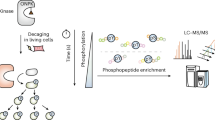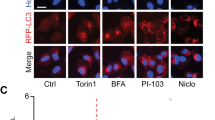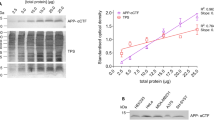Abstract
This protocol describes biochemical procedures to monitor the activation of the protein kinase C (PKC) family using PKCδ as the representative. The PKC family is composed of ten isoforms divided into cPKC, nPKC and aPKC groups, and their catalytic activity is regulated by multiple mechanisms. For example, PKCδ in the nPKC group is activated by diacylglycerol as a second messenger in the receptor-coupled manner, through tyrosine phosphorylation and protein complex formation in stress-stimulated cells, and by the caspase-catalyzed cleavage during apoptosis. The isoform is immunoprecipitated from cultured cells, the protein kinase activity is measured by in vitro kinase assay and the tyrosine phosphorylation and protein complex formation are characterized by immunoblot, whereas the generation of the catalytic fragment is detected by immunoblot in the cell extract. The combination of these procedures is useful to evaluate the activation states of the PKC family in cells. This protocol can be completed in 3–5 d.
This is a preview of subscription content, access via your institution
Access options
Subscribe to this journal
Receive 12 print issues and online access
$259.00 per year
only $21.58 per issue
Buy this article
- Purchase on Springer Link
- Instant access to full article PDF
Prices may be subject to local taxes which are calculated during checkout




Similar content being viewed by others
References
Nishizuka, Y. The role of protein kinase C in cell surface signal transduction and tumour promotion. Nature 308, 693–698 (1984).
Ohno, S. & Nishizuka, Y. Protein kinase C isotypes and their specific functions: prologue. J. Biochem. 132, 509–511 (2002).
Newton, A.C. Protein kinase C: structural and spatial regulation by phosphorylation, cofactors, and macromolecular interactions. Chem. Rev. 101, 2353–2364 (2001).
Parekh, D.B., Ziegler, W. & Parker, P.J. Multiple pathways control protein kinase C phosphorylation. EMBO J. 19, 496–503 (2000).
Kikkawa, U., Matsuzaki, H. & Yamamoto, T. Protein kinase Cδ (PKCδ): activation mechanisms and functions, J. Biochem. 132, 831–839 (2002).
Konishi, H. et al. Phosphorylation sites of protein kinase C δ in H2O2-treated cells and its activation by tyrosine kinase in vitro. Proc. Natl. Acad. Sci. USA 98, 6587–6592 (2001).
Yamamoto, T., Yamauchi, E., Taniguchi, H., Matsuzaki, H. & Kikkawa, U. Tyrosine phosphorylation of protein kinase C. in Methods in Molecular Biology 233, Protein Kinase C Protocols (ed. Newton, A.C.) 207–216 (Humana Press, Totowa, New Jersey, 2003).
Konishi, H. et al. Activation of protein kinase C by tyrosine phosphorylation in response to H2O2 . Proc. Natl. Acad. Sci. USA 94, 11233–11237 (1997).
Umada-Kajimoto, S., Yamamoto, T., Matsuzaki, H. & Kikkawa, U. The complex formation of PKCδ through its C1- and C2-like regions in H2O2-stimulated cells. Biochem. Biophys. Res. Commun. 341, 101–107 (2006).
Emoto, Y. et al. Proteolytic activation of protein kinase Cδ by an ICE-like protease in apoptotic cells. EMBO J. 14, 6148–6156 (1995).
Fukunaga, M. et al. UV-induced tyrosine phosphorylation of PKCδ and promotion of apoptosis in the HaCaT cell line. Biochem. Biophys. Res. Commun. 289, 573–579 (2001).
in Molecular Cloning: A Laboratory Manual 3rd edn. 3 (eds. Sambrook, J. & Russell, D.W.) A8.40–A8.55 (Cold Spring Harbor Laboratory Press, Cold Spring Harbor, New York, 1999).
Davies, S.P., Reddy, H., Caivano, M. & Cohen, P. Specificity and mechanism of action of some commonly used protein kinase inhibitors. Biochem. J. 351, 95–105 (2000).
Author information
Authors and Affiliations
Corresponding author
Ethics declarations
Competing interests
The authors declare no competing financial interests.
Rights and permissions
About this article
Cite this article
Yamamoto, T., Matsuzaki, H., Kamada, S. et al. Biochemical assays for multiple activation states of protein kinase C. Nat Protoc 1, 2791–2795 (2006). https://doi.org/10.1038/nprot.2006.420
Published:
Issue Date:
DOI: https://doi.org/10.1038/nprot.2006.420
Comments
By submitting a comment you agree to abide by our Terms and Community Guidelines. If you find something abusive or that does not comply with our terms or guidelines please flag it as inappropriate.



